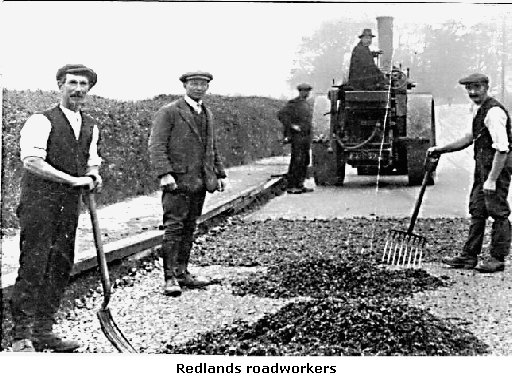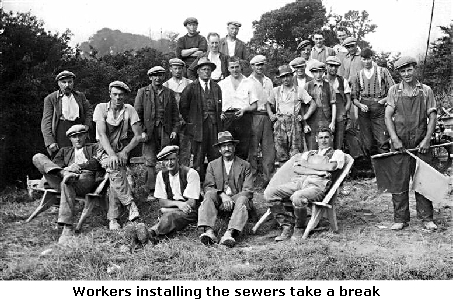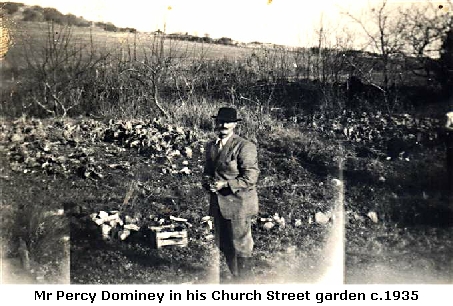

Village Life in the 1930's 1/2
The 1930's saw a great deal of change in the village, gas and electricity arrived. Council houses were built in Chapel Lane to provide homes for some of the villagers who were living in poor housing around the village. Private individuals were building houses, both for their own occupation and for rent. Many villagers had misgivings when the village became part of the Weymouth Borough Council in 1933 as they felt that their identity would be lost.
At the beginning of 1930 work was carried out to the 'most dangerous' corner in Upwey. The steep climb up Stottingway Street had always tempted motorists to rush the last bit, making the junction with the Dorchester Road the scene of more accidents than even the famous hairpin bend at Ridgeway. The situation was so bad that the RAC posted a scout there to control the traffic. In February council workmen began improvements which involved rounding off the corners and setting back hedges to give a wider view across the corner. A footpath provided some protection for pedestrians.
Roadworks were a common sight during the early years of the thirties as the Weymouth Consumer Gas Company were making their way through Upwey and Broadwey to make gas available to residents in both villages, which could be used for both lighting and cooking.
In the spring of 1930 the parish council, after much discussion, decided to adopt the Public Lighting Act. They agreed to provision of gas lamps as the gas main was to be laid right up to and beyond the Wishing Well, whereas Weymouth Corporation did not intend to make electricity available this far into the village.
The council agreed on 17 sites for lamps covering 3700 yards of road: corner of Victoria Ave, midway between Victoria Ave and Stottingway, Stottingway corner, midway between Stottingway and Prospect Place, Prospect Place, Royal Oak, two between Royal Oak and Lane End (now Elwell Street), Lane End junction with Church St, Masons Arms, two between Eastbrook corner and Lane End, Eastbrook corner, two between Lane End and the Wishing Well, Wishing Well, corner of Friar Waddon road at a cost of £59 per annum (a 4d rate). This cost included supply and fit 150 candle power lamp columns and maintenance (cleaning, lighting/extinguishing), insurance and re-
A rather obscure benefit of adopting the act was that it would secure the services of the fire brigade.

Parish council meetings, along with the Mothers Union met in the Reading Room at the bottom end of Elwell Street. The British Legion met at the Royal Oak and regularly held smoking concerts there under the patronage of publican J Dailey. The WI hut on the Dorchester Road was very much the social centre of the village with dances, whist drives, jumble sales and concerts being held there.
The Brownies and Guides met at the WI Hut. Miss Alice Mayo from Coryates was the Girl Guide Captain. There was great excitement and anticipation in the weeks running up to Thursday 1 May 1930, when Princess Mary would attend a rally at Kingston Maurward Park. Upwey School closed for the day as many of the children were among the guides and scouts attending from all over Dorset.
The weather was glorious and the Princess looked very smart in the uniform of the President of the Girl Guides Movement. At 2.30pm the Princess walked to the saluting base through a guard of honour. The march past of more than 3000 guides lasted for more than 25 minutes and was a wonderful sight. Among the standard bearers were Edith Didcot, Edith Pearce and Christine Davage from the Upwey troup.
The scout group met in the old chapel next to Southbrook House in Church Street and was led by Captain Borrodale-
Living conditions in some of the cottages were poor, many were condemned and decent housing was scarce. Upwey Parish Council, led by Mr Percy Lovell campaigned for Weymouth Rural District Council to build houses to rent.
Hilda Tidby moved to Upwey, aged 18, when she married postman Harry in 1929. Initially they lived with Granny Tidby on the Old Roman Road. A little later they rented a cottage at Little Hill from Jack Symonds who lived on East Hill. The cottage had two rooms downstairs and one up. There were shutters on the windows which were closed at night to protect the glass from people leaving The Ship. Cockroaches were a terrible problem, Harry filled every hole to stop them coming in. Once Mrs Hutchings, who lived next door, said to him 'Have you got any cockroaches in there?'. He replied 'No, they're all with you!'
Land was purchased on the northern side of Chapel Lane and seven pairs of semi-
A major change to the administration of the village occurred on 1 April 1933 when the Dorsetshire Review Order came into force. This meant that Upwey, Broadwey and Preston became part of the Borough of Weymouth. There were very mixed feelings in the village, with many people worrying that the village identity would be lost.
The results of the first elections of the new Weymouth Borough Council in November 1933 were announced to a large crowd at Broadwey School. Of the 1560 electors in Upwey and Broadwey, 1310 (84%) voted and elected J A Pridham, P Lovell and D Hinchcliffe to represent them.

Upwey Parish Council -
After a period of over 38 years Upwey Parish Council ceased to exist with the merging of the village with the borough on 1 April 1933. The final meeting was held on 10 March in the schoolroom. The first meeting had been held on 4 December 1894, when Mr T J Lovell, father of Percy, presided. During the 39 years of the council's life, exactly 50 men were elected and signed the roll accepting office. Of those Mr Percy Lovell had the record for the longest term of office, he was elected in 1913 and remained a member until the end. Mr John Foot would have beaten this record if he had not resigned from the council and chairmanship in 1929. He was elected in 1910 and served 19 years. W Davey held the record of attendance, he was first elected in 1919 and never missed a meeting.
Although the executive powers of parish councils were strictly circumscribed by a local government act, the council had a long record of useful service and implemented many improvements to the village amenities. Water, gas and electricity were made available. Mainly by the work of the committee the churchyard was extended by voluntary effort instead of the parish being saddled with the burial board special rate. The collection of rubbish was arranged by the Rural District Council after three years of repeated requests by Upwey Council. The Poor Lot was fenced by public subscription and its revenue increased for the benefit of the poor by the hard work of the council of the day.
The Wishing Well halt was provided by the Great Western Railway in response to a request by the council and a cheap return ticket for Broadwey and Upwey was also obtained from the Southern National Omnibus Company as a result of representations made by the clerk of the council. The need for council houses was first made by Mr F J Strange in 1919 and Upwey Council fought the most strenuous fight of their existence until all difficulties were overcome and in 1928 saw the RDC embark on a scheme which has been of incalculable benefit to the whole district. By 1933, 22 houses had been erected. Footpaths and rights of way have been safeguarded. Altogether the council have earned the goodwill of the village by their gratuitous service on behalf of those they were elected to serve.
The roads were to be dug up again as under the 1933 Review Order Weymouth Borough Council had to make arrangements for the construction of a sewerage system in the three villages within five years. One or two rather strange arrangements were made. In Stottingway Street, Fred Virgin who owned two of the terrace of four cottages (now numbers 11-

Fred's grandson (also Fred) and his family would agree, as they had to cope with workmen digging a deep trench right through the middle of their house!
Upwey Allotments comprised of approximately 9.5 acres of land on the north side of Friar Waddon Road, next to East Hill Dairy. In 1933 there were 61 tenants who paid 41/2d per rod. Many saw the rise to 5d per rod from April 1934 as a direct result of coming into the Borough.
A field on the right of Chapel Lane was used by Fossett's circus and Townsend's fair as a resting place before they set up in Weymouth and at Portland. The circus generally came during the summer whilst Townsend's arrived at the end of October/early November as they were on their way to Portland Fair. These visits were one of the highpoints of village life and were enjoyed by all young and old -
However Townsend's fair was by far the most exciting as the men would set up round-
Mrs Tidby who lived opposite always had trouble getting her children to go to bed when the circus or fair was there, as they could watch the goings-
Recycling was popular. Children would collect empty 'pop' bottles and receive a couple of coppers for them from the pubs and shopkeepers. Mr Little, the rag and bone man, was a regular visitor who would take on any unwanted items that looked useful to him. Rabbit was a popular source of meat and many housewives dried the skins on the walls of the cottages and sold them to Mr Little. Any other household rubbish not put on the compost heap was collected by the council 'dust-
Milk could be obtained from various sources; Alf White was a milkman working for Ray Rogers who had the dairy at the junction of Jesty's Avenue and Old Station Road. Bert Legg, one of the five sons from Icen Farm, carried milk churns on specially made platforms built onto the side of his bicycle. He'd arrive at your door with a pail of milk and using measures fill your jug. Other local farmers like the Virgins and Wards sold their milk to the Milk Marketing Board and provided milk to friends and family. The milk churns were taken to Upwey Station to be loaded onto the London train.
Eddie 'The Baker' was a very busy man, along with Mr Baker, his son Dick and Ben Trevett, he helped to made the bread and cakes in the bakery. On hot days when they left the door open you could stand and watch them at work. When the bread was ready Eddie filled up his handcart and set off on his bread round. The handcart had a lid operated by a ratchet and the smell of freshly baked bread that wafted out when the lid was opened was wonderful. The early morning special delivery of hot cross buns on Good Friday was always eagerly awaited. Mr Baker also had a horse and cart that was used to deliver to customers living some distance away.
Another supplier of ready-

Watercress was easily grown in the area, including next to the mill and behind 104 Church Street where Mr Dominey took his watercress to the station, to be taken to the London markets, on a tricycle fitted with carriers which would be filled with boxes packed with bunches of watercress. This tricycle had previously belonged to Roger's Dairy and was obviously well looked after as Mr Dominey's granddaughter can remember being given rides around the garden in it in the early 1960's.
Mrs Frances Preston opened up her Westbrook House grounds for church fetes and Conservative garden parties, this became somewhat of a tradition and continued when the Thoyts family took up residence in 1937. Pat Wills (nee Fellowes) remembers there being
baby shows and competitions for children such as collecting different types of wild flowers and 'who could catch the most white butterflies'. Looking back Pat can see that the butterfly competition also served a useful purpose -
The Armistice Day parade was always very impressive. The remembrance day service alternated between Upwey and Broadwey churches. In 1934 the men of Broadwey and Nottington marched from Broadwey church, where Lt Gordon-
King George V's Silver Jubilee in May 1935 was marked by a programme of sports in a field off Chapel Lane, lent by Mr O W Baker. Just under £19 had been donated by local residents to enable the occasion to be celebrated. The sports events started in the early afternoon and continued until late evening. The fund enabled tea to be provided for 150 children and 80 parents in the WI Hut. At 2.15pm the children gathered on the green at the bottom of Stottingway Street and headed by the wireless van of Dawes of Dorchester and village worthies, they marched to the field. As the children left the field at the end of the day they were presented with oranges and sweets by Mrs P Lovell. The fund was also sufficient for 200 children to receive a Silver Jubilee mug and for all villagers over the age of 70 years who were drawing the old age pension to receive a hundredweight of coal.

